How Napoleon's pistols came to Queensland
By Dr Robin Trotter, 2021 Queensland Business Leaders Hall Of Fame Fellow | 11 February 2022
Guest blogger: Dr Robin Trotter - 2021 Queensland Business Leaders Hall of Fame Fellow.
Q: What might the connection be between Napoleon Bonaparte and Queensland businessman Sir Arthur Petfield?
A: A pair of eighteenth century pistols and Sir Arthur Petfield’s ancestor, Lieutenant Captain Mott (1786-1818).
Napoleon's pistols as displayed in West Point Museum, New York.
Source: Brighouse/Mott Family Archives - John Ann Tyrell Mott, Joy Olney, 2020.
Andrew Mott Jnr was born 19 March 1786 in Liverpool. He was the son of Andrew Mott (Snr) and Jane Mott, and was baptised 4 April 1786 in St Paul, Lancashire. Andrew Mott Jnr was a First Lieutenant in the British Royal Navy and in 1815 he was on active duty on the Bellerophen, a Royal Navy vessel that was part of the British and United States ships blockading the French ships in the port of Rochefort following the defeat of Napoleon at Waterloo.
A footnote to Captain Maitland’s memoirs, added to the text from the memoirs of midshipman Homes, tells us a little about his First Lieutenant:
Andrew died at 32 years from a head injury and was buried 30 June 1818 in St Mary, Sculcoates, near Hull, Yorkshire.
Q: How did the pistols come into the possession of Lieutenant Captain Mott?
A:
Napoleon, following his defeat earlier (18 June 1814), agreed to surrender to the British rather than be exiled to the United States of America, and to accept the ‘hospitality’ of Britain. On 15 July, Napoleon boarded the French brig, L’Epervier, from which he was later transported by barge to the Bellerophon. where her captain, Captain Maitland, was awaiting Bonaparte’s arrival to accept his surrender. Maitland recorded in his memoirs:
It is recorded that Napoleon surrendered his sword to Captain Maitland:
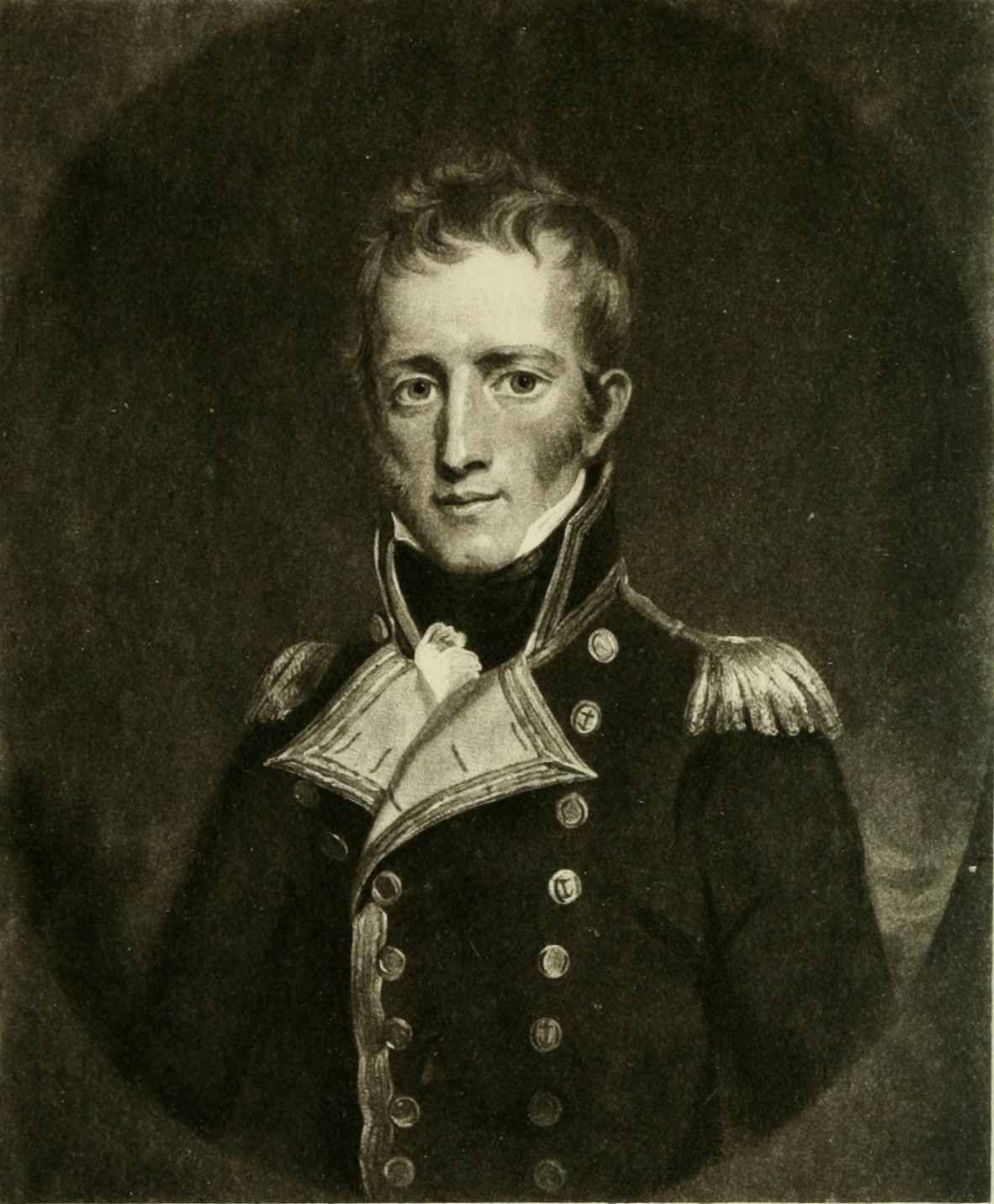
Frederick Lewis Maitland, Bellerophon's last captain, and the man who received Napoleon's surrender. An 1826 engraving of a portrait by Samuel Woodforde.
Source: Wikipedia HMS Bellerophon (1786). Original Source: Frontispiece of the 1904 edition of Frederick Lewis Maitland's 1826 book, The Surrender of Napoleon.
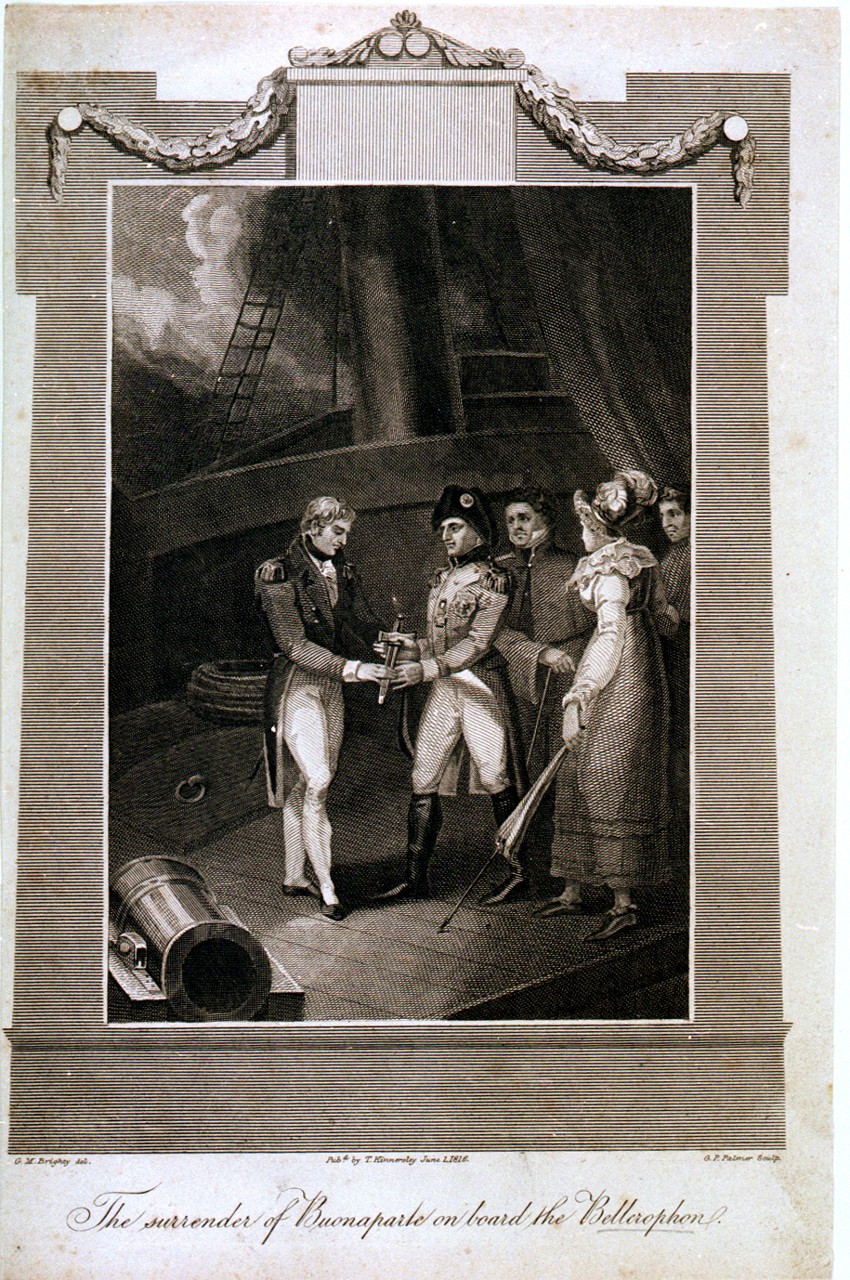
The surrender of Buonaparte on board the Bellerophon, a popular, and somewhat stylised, 1816 print by G. M. Brighty, showing the moment of Napoleon's surrender to Captain Maitland.
Source: Wikipedia, The surrender of Buonaparte on board the Bellerophon. Original Source: G M Brighty, 1816, National Maritime Museum.
Q: What is the evidence that the pistols owned by Sir Arthur Petfield’s family were those of Napoleon Bonaparte?
A: The Napoleonic insignia – ‘N’ enclosed with laurel wreath and crown - on the base of the stock of each pistol:
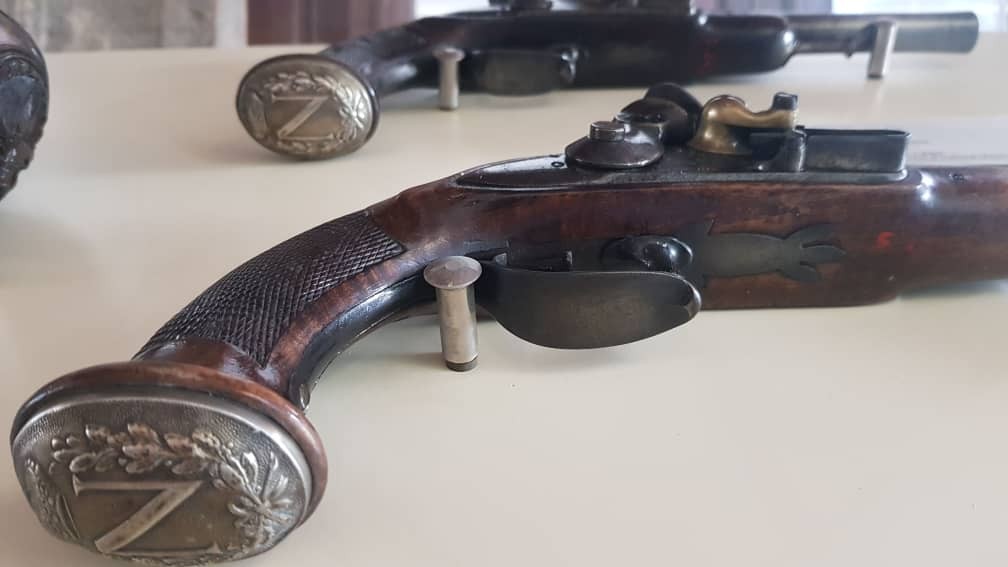
Napoleon's 2 pistols found in Museo Napoleonic, Havana, Cuba.
Source: Brighouse/Mott Family Archives, Joy Olney, 2020.
AND Mott family records the pistols passed through the family to Andrew Luther Mott (1820-1904). The family records also note that he had insured the pistols for 10,000 English pounds and that they were loaned by him to the Royal Naval Exhibition held at Chelsea, 2nd May, 1891. In the Exhibition Catalogue Guide, the pistols were described as having belonged to Napoleon Bonaparte.

Royal Naval Exhibition, 1891: Official Catalogue Guide, Opened at Chelsea, May 2nd, 1891. Page 337.
Source: Internet Archive.
Passed down through the Mott family to the Petfield family is a pamphlet accompanying the exhibit:
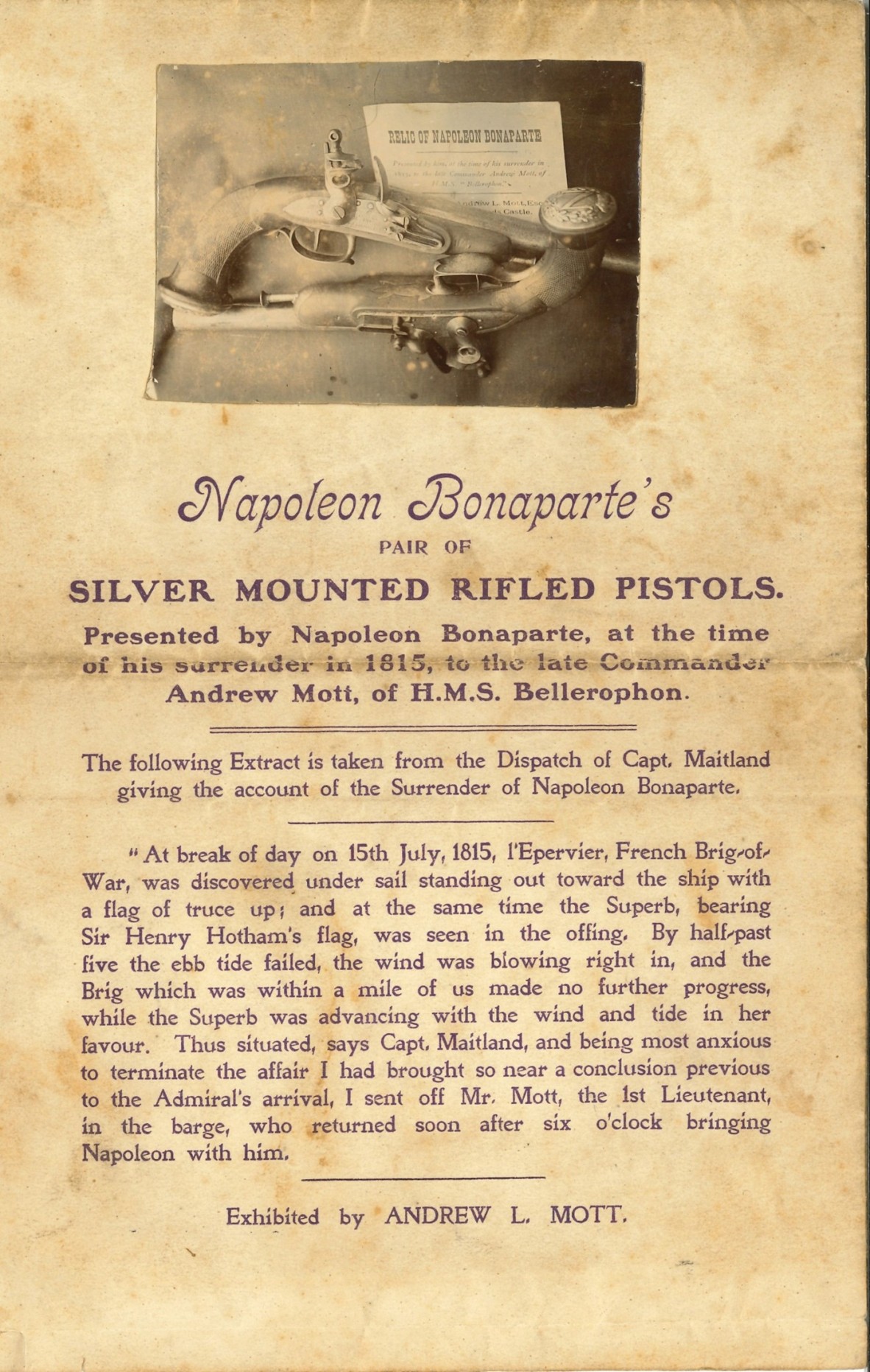
Napoleon Bonaparte's pair of silver mounted rifled pistols. Pamphlet accompanying the items for the Royal Naval Exhibition held at Chelsea, 2nd May, 1891.
Source: 29378 Arthur Henry Petfield Papers 1938-1978, John Oxley Library, State Library of Queensland.
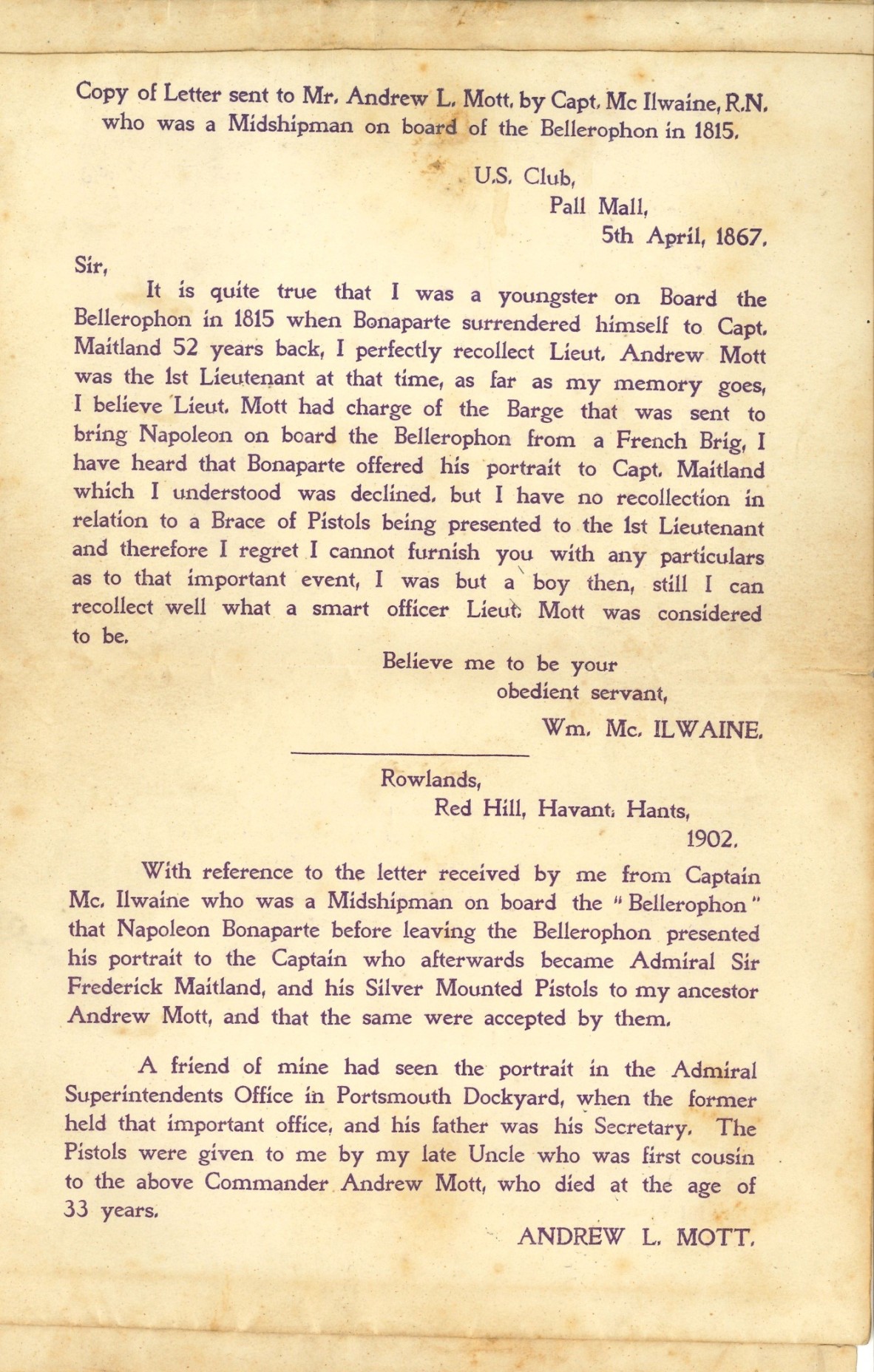
Napoleon Bonaparte's pair of silver mounted rifled pistols. Pamphlet accompanying the items for the Royal Naval Exhibition held at Chelsea, 2nd May, 1891.
Source: 29378 Arthur Henry Petfield Papers 1938-1978, John Oxley Library, State Library of Queensland.
In addition, the family records as further evidence, a certificate authenticating the pistols’ provenance and signed by both Albert Edward (King Edward, then Prince of Wales), and by Admiral W. McDowell.
Q: How did the pistols come to Queensland?
A: Passed down through the Mott family.
Andrew Luther Mott’s widow, Mary, gifted the pistols to a visiting family member, John Wesley Mott, an Australian surveyor who had enlisted in Brisbane for WWI, and was a Lieutenant in the 6th Field Engineers. John Wesley Mott had already distinguished himself being awarded with both a Distinguished Conduct Medal. British War Medal, Military Cross and a Victory Medal. Whilst on military leave he visited his English relations and on the visit he was perceived to be a suitable custodian of the family treasures – Napoleon’s pistols. After the war, John Wesley Mott returned to Australia and to his surveying profession, settling in Toowoomba. In retirement he moved back to his birth place, Brisbane, where he died in 1979.
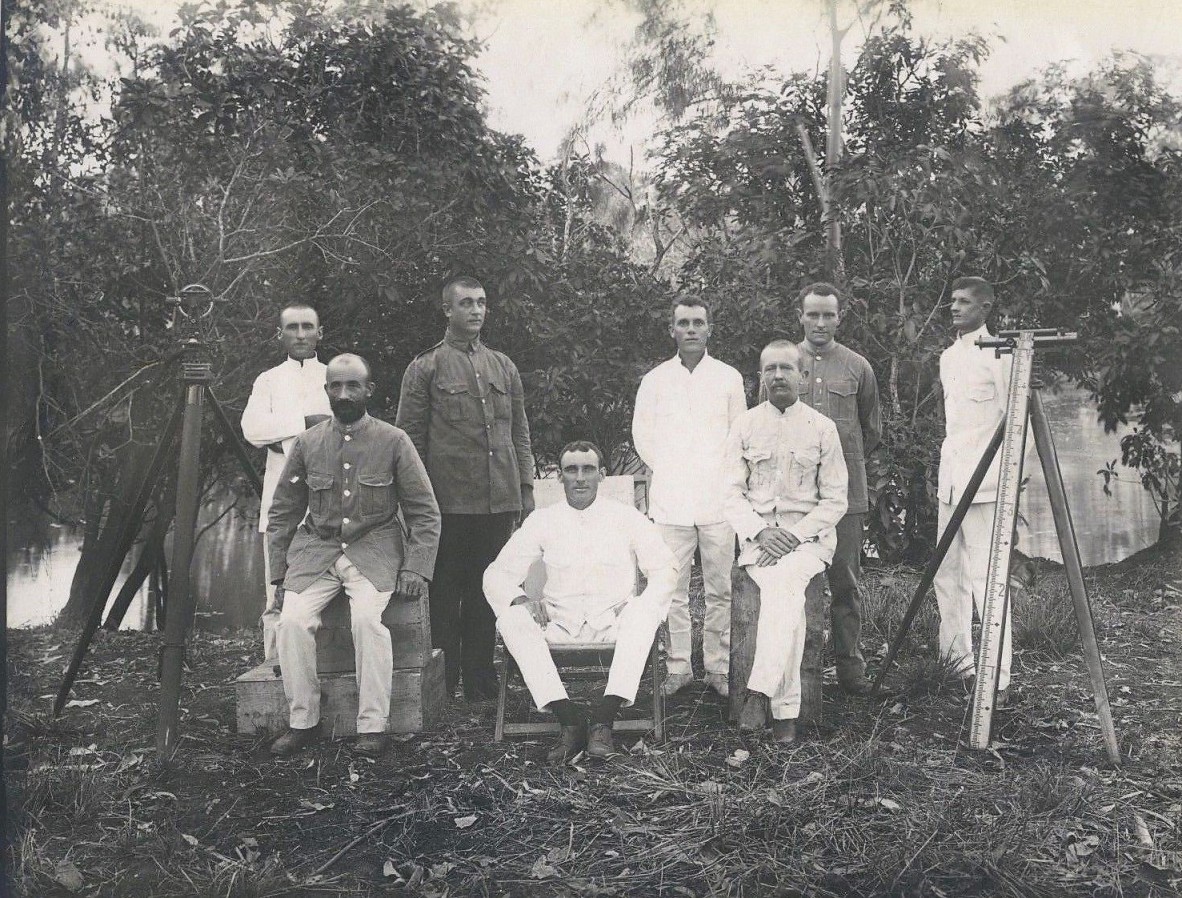
John Wesley Mott seated in chair. He led a party surveying party to the Roper River and Katherine regions of the Northern Territory in 1913-1915.
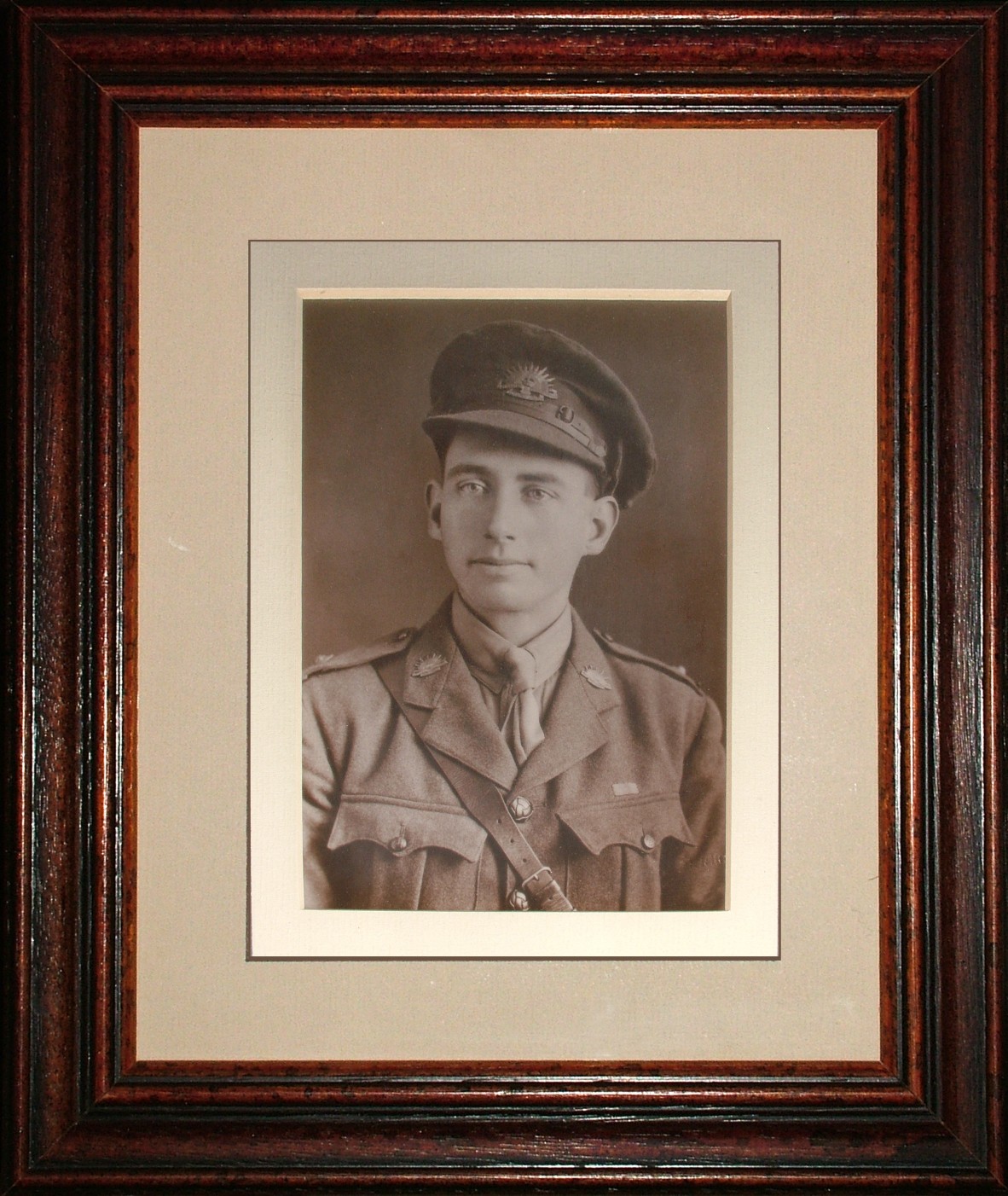
John Wesley Mott Jnr.
Source: Library & Archives NT. John Mott, , Territory ANZACs, Returned ANZACs, First World War, 1914-1918, https://hdl.handle.net/10070/655941.
Q: Where does Sir Arthur come into the story?
A:
This requires a detour into family history. John Wesley Mott (1897-1997) was the son of William Thomas Mott and Caroline Madeline (Banks). William Thomas was in public service in Queensland. He was one of nine children of John Wesley Mott and Diana Sarah (Jeves) who emigrated to Queensland in 1862 with four children (the other five children being born in Australia). William Thomas’s siblings were: John Wesley, George William, Sarah Annie, Samuel Henry, Isabella Phoebe, Andrew, Alice, and Jane Elizabeth. Our John Wesley was a surveyor who, after serving in World War I, returned to surveying practice in Bundaberg, eventually settling in Brisbane. The pistols were securely lodged in a safe deposit vault of the Queensland Trustees Ltd., Brisbane, when The Brisbane Courier journalist, Spencer Browne, was taken by John Wesley’s father, W.T. Mott, to inspect the pistols. Spencer Browne’s report appeared in the newspaper on 27 August, 1927. Although the pistols were the property of his son, William Thomas told Browne that:
The pistols stayed in the Mott family until, in approx 1956, Mrs J.W. Mott took the pistols to Melbourne to be auctioned.
![Woman Says Pistols were Napoleon’s, newspaper clipping, 1956 [no source or date recorded].](/sites/default/files/styles/slq_standard/public/Napoleon%27s%20pistols.jpg?itok=QmUl1qpS)
Woman Says Pistols were Napoleon’s, newspaper clipping, 1956 [no source or date recorded]
Source: 29378 Arthur Henry Petfield Papers 1938-1978, John Oxley Library, State Library of Queensland.
Q: What happened to the pistols?
A: Mott family records report that the pistols were purchased by a collector from Cuba, Julio Lobo, and they are now in the Museo Napoleonic, Havana, Cuba.
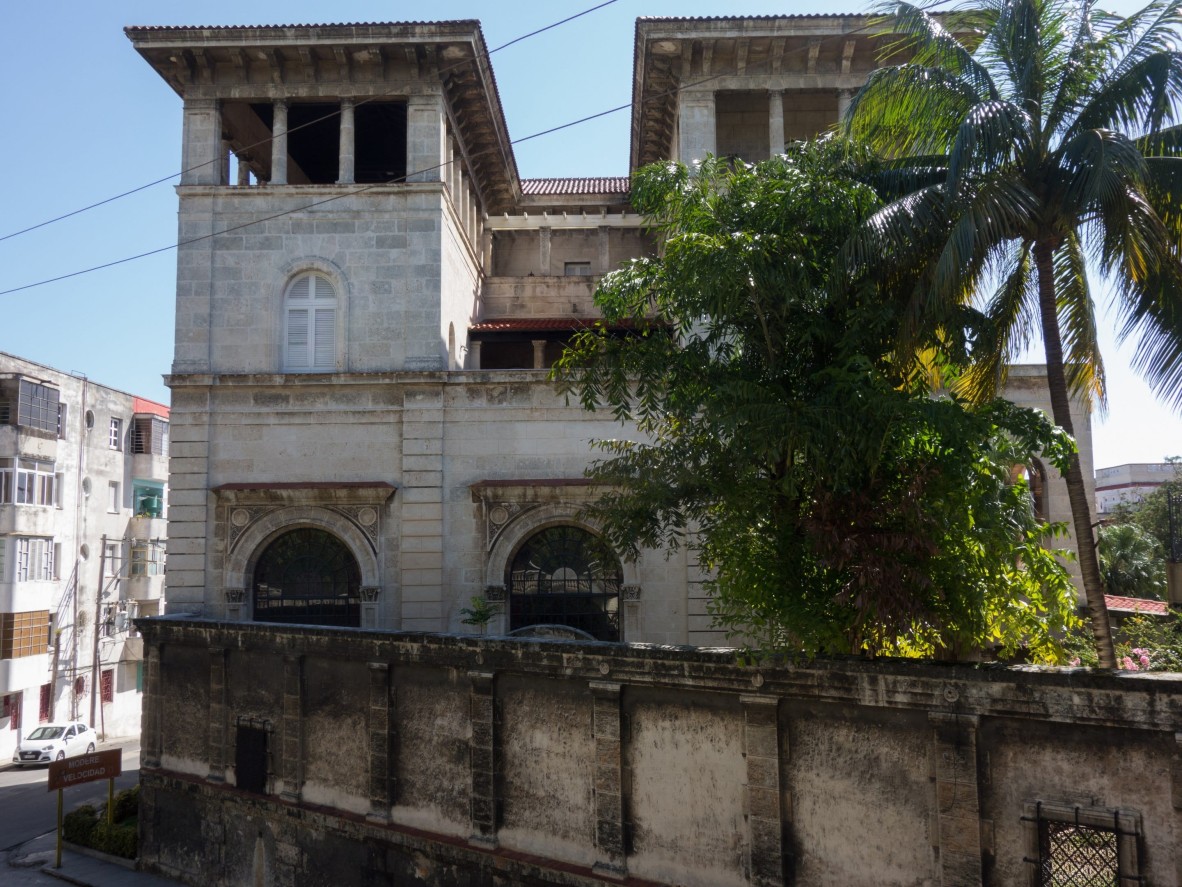
Napoleon's pistols are now held by the Museo Napoleonic, Havana, Cuba.
Source: Wikipedia Museo Napoleónico (La Habana)
Q: The final link?
A:
Familial relationships. To make the connection between Napoleon’s pistols and Sir Arthur Petfield, we need to return to the family history and to William Thomas’s brother, Samuel Henry Mott (1854-1948) and his wife, Lydia (Thompson). Their daughter, Florence Jane Mott married Arthur Petfield Snr and they had four sons, Arthur Henry (later Sir Arthur), Colin, Ronald and Earnest.
Finally, we might ask: Did Sir Arthur ever see the pistols? That we don’t know. We do know he was familiar with the family history and the story of the pistols being handed down through the Mott family to ultimately his great uncle’s son, John Wesley, as newspaper clippings relating to the pistols were collected and kept by Sir Arthur as part of his family records. Arthur would have been about 15 when the pistols were shown to Spencer Browne. Can you imagine a young lad not wanting to at least see the pistols of Napoleon Bonaparte when they were in the possession of his relatives?
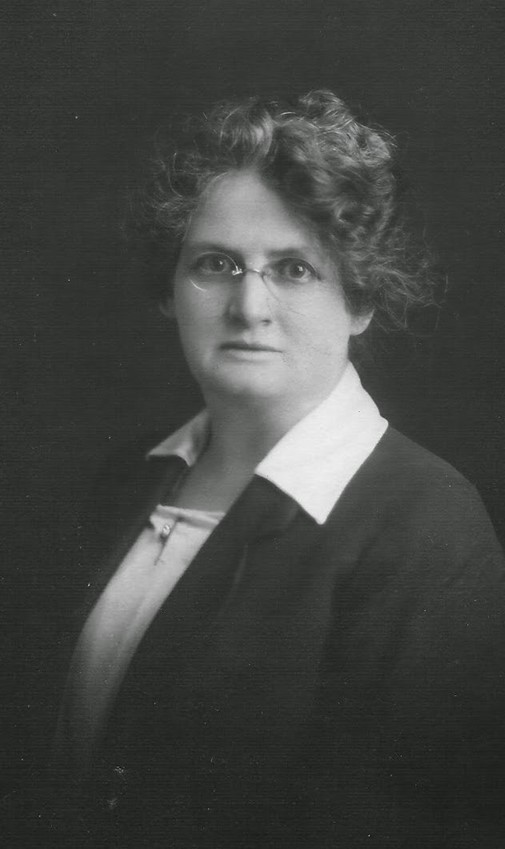
Caroline Madeline Mott, mother of John Wesley Mott, Surveyor and war hero.
Source: Brighouse/Mott Family Archives - Samuel Henry Lydia Thompson Mott, Joy Olney, 2020.
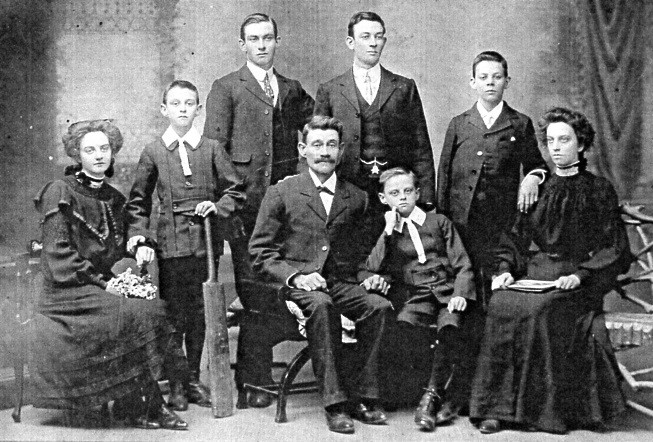
The Samuel Henry Mott family. Standing - Alfred, Samuel, William, Leopold. Seated – Florence [Sir Arthur’s mother}, Samuel, Arthur, Lydia Mott .
Source: Brighouse/Mott Family Archives - Samuel Henry Lydia Thompson Mott Joy Olney, 2020.
![Arthur and Florence Jane (Mott) Petfield [Sir Arthur’s parents] . Married – 1 January, 1912](/sites/default/files/styles/slq_standard/public/Arthur%20Petfield%20%26%20Florence%20Mott%20married%201%20January%201912.jpg?itok=utDYIoCs)
Arthur and Florence Jane (Mott) Petfield [Sir Arthur’s parents] . Married – 1 January, 1912.
Source: Brighouse/Mott Family Archives - Samuel Henry Lydia Thompson Mott, Joy Olney, 2020.
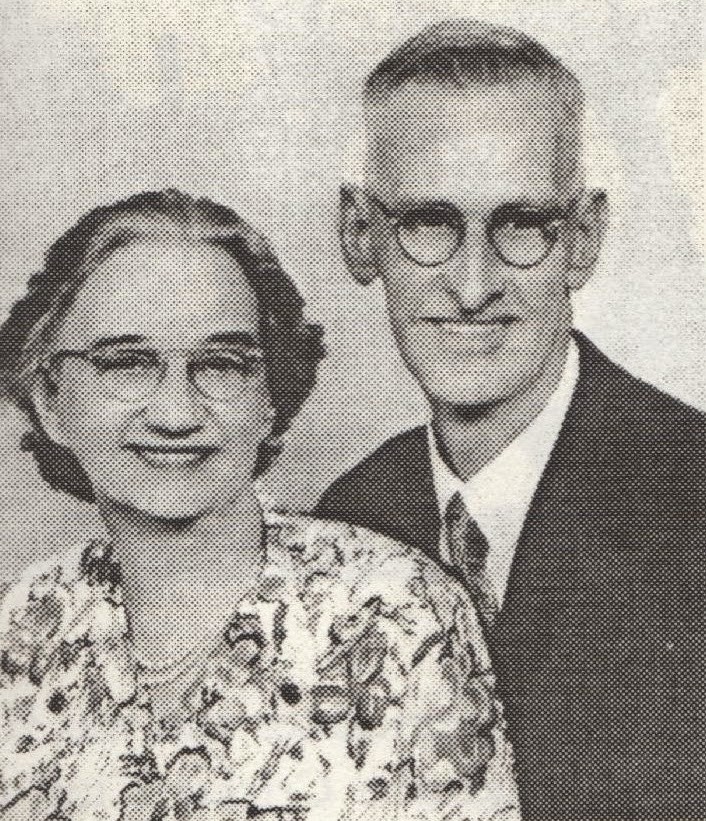
Florence Jane and Arthur Petfield (Sir Arthur’s parents) – Florence died 12 April 1968 and Arthur died 20 June, 1974.
Source: Brighouse/Mott Family Archives - Samuel Henry Lydia Thompson Mott, Joy Olney, 2020.
Dr Robin Trotter
The Queensland Business Leaders Hall of Fame is an initiative of QUT Business School, State Library of Queensland and the Queensland Library Foundation.
Collections
References
- Olney, Joy., 2020, Napoleon surrendered his 2 pistols to First Lieutenant Andrew Mott, Brighouse/Mott Family Archives.
- Browne, S., 1927, Napoleon’s Pistols in Brisbane, The Brisbane Courier, Saturday, 27 August.
- Homes, G., 1838, Memoirs of an Aristocrat, by a Midshipman of the Bellerophon, Whittaker & Co., London and Bell & Bradfute, Edinburgh (George Home, was the son of Lieutenant A. Home, R.N.
- John Wesley Mott, Discovering ANZACS, National Archives of Australia
- Maitland, Sir Frederick Lewis, 2009, (ed. William Kirk Dickson), The Surrender of Napoleon; Being the narrative of the surrender of Buonaparte, and of his residence on board H.M.S. Bellerophen, with a detail of the principal events that occurred in that ship between the 24th of May and the 8th August 1815, Project Gutenberg, Ebook F28934.
- Markham, David J., 2008, The Road to St Helena, Napoleon after Waterloo, Pen and Sword Books, Barnsley, UK.
- Napoleonic Museum (Havana).
- Royal Naval Exhibition, 1891: Official Catalogue Guide, Opened at Chelsea, May 2nd, 1891. (Classic Reprint) Author Unknown. Paperback – 7 February 2018.
- Woman Says Pistols were Napoleon’s, newspaper clipping, 1956 [no source or date recorded], Sir Arthur Petfield Papers, John Oxley Library, State Library of Queensland.
Related Blogs:
Comments
Your email address will not be published.
We welcome relevant, respectful comments.